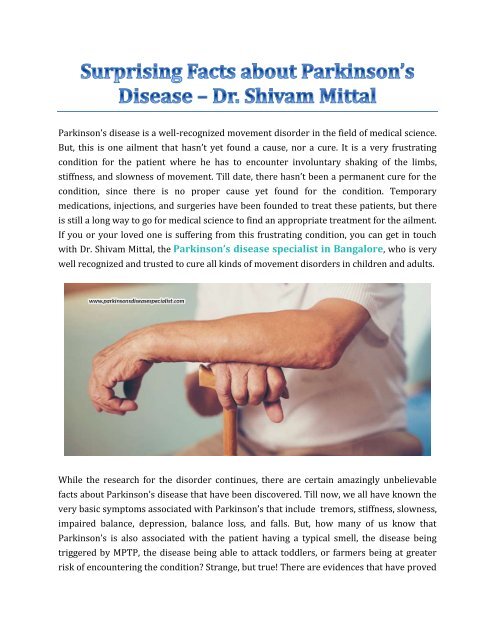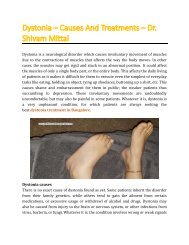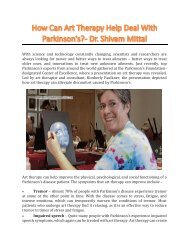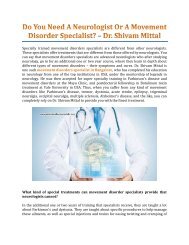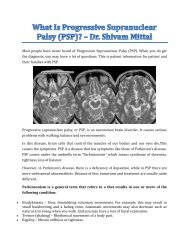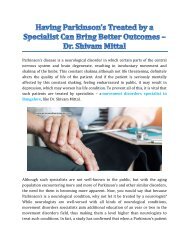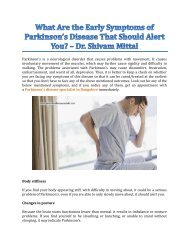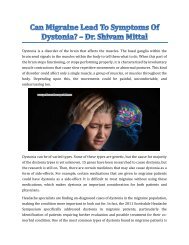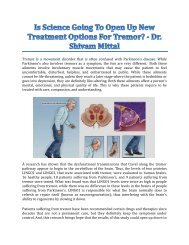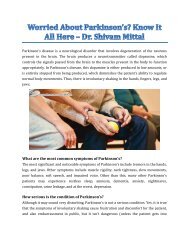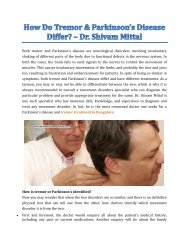Surprising Facts About Parkinsons Disease
Create successful ePaper yourself
Turn your PDF publications into a flip-book with our unique Google optimized e-Paper software.
Parkinson’s disease is a well-recognized movement disorder in the field of medical science.<br />
But, this is one ailment that hasn’t yet found a cause, nor a cure. It is a very frustrating<br />
condition for the patient where he has to encounter involuntary shaking of the limbs,<br />
stiffness, and slowness of movement. Till date, there hasn’t been a permanent cure for the<br />
condition, since there is no proper cause yet found for the condition. Temporary<br />
medications, injections, and surgeries have been founded to treat these patients, but there<br />
is still a long way to go for medical science to find an appropriate treatment for the ailment.<br />
If you or your loved one is suffering from this frustrating condition, you can get in touch<br />
with Dr. Shivam Mittal, the Parkinson’s disease specialist in Bangalore, who is very<br />
well recognized and trusted to cure all kinds of movement disorders in children and adults.<br />
While the research for the disorder continues, there are certain amazingly unbelievable<br />
facts about Parkinson’s disease that have been discovered. Till now, we all have known the<br />
very basic symptoms associated with Parkinson’s that include tremors, stiffness, slowness,<br />
impaired balance, depression, balance loss, and falls. But, how many of us know that<br />
Parkinson’s is also associated with the patient having a typical smell, the disease being<br />
triggered by MPTP, the disease being able to attack toddlers, or farmers being at greater<br />
risk of encountering the condition? Strange, but true! There are evidences that have proved
all of the above being right. Here are the stories behind these four amazing facts about<br />
Parkinson’s disease, which have paved the way to better researching for a cure for the<br />
condition.<br />
Parkinson’s <strong>Disease</strong> patients have a typical smell<br />
Joy Milne was married to Les, who was diagnosed with Parkinson’s disease more than a<br />
decade after Joy had noticed a distinct change in his smell. Obviously, she couldn’t link to<br />
the relation between his ailment and smell at that time, but years later, when she<br />
encountered a group of people suffering from the ailment, she noticed the same musky<br />
smell coming from them. This is when she deduced that Parkinson’s disease did have a<br />
smell. To make this assumption a definite call, she was made to smell 12 Tshirts – 6 of<br />
which were of Parkinson’s disease patients, and 6 of which were of normal people. She<br />
identified 7 being of Parkinson’s patients and 5 being of those without the ailment. Her<br />
sense of smell was not proven 100% accurate then, but 8 months later, when the 7 th out of<br />
the group of 12 was diagnosed of having Parkinson’s, she made headlines for being the lady<br />
who could identify Parkinson’s by no diagnoses other than the smell of her nose! This<br />
makes the point clear that Parkinson’s does have a distinctive smell, and one that is<br />
observed months or even years before the disorder strikes. While science hasn’t yet been<br />
able to come up with such a diagnosis, but if this distinctive smell can be identified at the<br />
earliest, millions of patients can be treated and cured even before the ailment occurs!<br />
Parkinson’s <strong>Disease</strong> is triggered by MPTP<br />
This story goes back to the year 1982, when a certain George Carillo was seen to develop<br />
the symptoms of Parkinson’s overnight. It became apparent after much investigation that<br />
Carillo had taken a street drug designed as a synthetic heroin, contaminated with a<br />
chemical called MPTP, which was the cause for triggering the symptoms of Parkinson’s.<br />
Carillo, and many others who had taken the same drug, were treated with levodopa, the<br />
same treatment given to Parkinson’s disease patients. After this case, it was researched and<br />
found that MPTP gets converted into a toxic molecule called MPP+ in the brain, which<br />
caused Parkinson’s. the transformation was caused by an enzyme called ACE-B, which<br />
deduced that ACE-inhibitor-drugs could prevent the symptoms.
Parkinson’s <strong>Disease</strong> can attack toddlers<br />
Parkinson’s is generally observed in people above the age of 50-55, with the risk<br />
exponentially increasing with risk. But, there are also conditions of early-onset Parkinson’s<br />
where it can attack between the age of 21-45, which accounts for 5-10% of all Parkinson’s<br />
cases. In fact, this can even go below the age of 21, where it is classified as juvenile<br />
Parkinson’s. To support this fact, a 2 year old toddler in Canada was diagnosed with<br />
Parkinson’s in 2016, which has been the youngest example ever seen!<br />
Farmers are at a greater risk of Parkinson’s <strong>Disease</strong><br />
Pesticides have long been linked to Parkinson’s with lots of evidence substantiating the<br />
condition. There are in particular three pesticides that can increase the risk of developing<br />
Parkinson’s, namely ziram, maneb, and paraquat. And, when pesticides are in connection<br />
with Parkinson’s, it is commonsensical that farmers are definitely at high risk.<br />
For more information, visit: http://www.parkinsonsdiseasespecialist.com/


